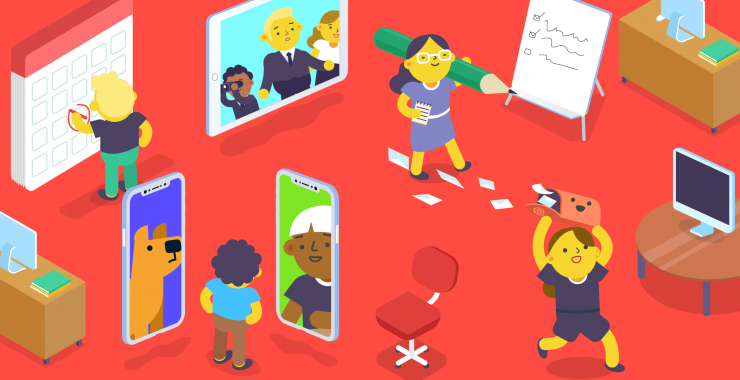Cross functional collaboration is vital for the success of a remote team. Unfortunately, according to a study published in the Harvard Business Review 75% of the times, a cross functional team is dysfunctional.
Yet, OWL Labs claimed that in 2019, individual contributors in the United States were 20% more likely than average to work remote full time.
America, especially, is rapidly turning toward working remotely. Therefore, with the demand and accessibility of online employees becoming more commonplace, finding a way to improve cross functional collaboration between the disciplines of your team is essential.
Importance of cross functional collaboration
A cross-functional team is a group of team members from various departments that combine diverse skill sets to work on a project or pursue a shared objective.
Being in a cross-functional team has many advantages, but it also has drawbacks for any organization.
A cross-functional team may feature individuals who each bring conflicting work methods and working approaches to the table.
Cross functional collaboration promotes efficiency within the company, lowers expenses, and fosters adaptability and innovative problem-solving. Most importantly, it maintains everyone focused on the long-term objectives of the business.
Project managers and team leaders must establish ground principles for the group, lay out a precise procedure for making decisions, and promote open communication and flexibility in order to overcome these obstacles.
However, it’s essentially important and advantageous if executed properly.
A cross functional team collaboration can help team members achieve the following:
- Teamwork makes the dreamwork
- Team members are more productive
- Team members learn from each other
- Diverse ideas and skill sets are brought to the table
- Employees are able to build better leaderships skills
Tips on improving cross functional collaboration
The reality is that an effective cross functional team necessitates trust.
Building a trusting relationship with someone when you labour in the same space together is challenging enough.
When teams from various departments are working together, this challenge gets progressively harder.
We’ve compiled a list of 5 easy steps that have helped us create a genuinely collaborative environment to give you ideas on how you can improve cross-team collaboration in your company.
Clear task-handling guidelines
Clear guidelines on how to handle project tasks are vital for organizing a cross-discipline team and enabling them to collaborate effectively.
Simple organizational steps such as color-coding tasks in your team app based on ownership, or the skill sets required, and assigning sub-tasks to individual team members, helps everyone know which tasks they need to focus on.
Additionally, you should also have a system in place that everyone follows for noting the priority and deadline of each task. This helps the team to work together on the most important tasks to ensure progress isn’t held up.
Similarly, get everyone on your team into the habit of updating tasks with the latest progress and marking tasks as in-progress when they get started on them. This helps encourage a more proactive approach to cross functional collaboration by keeping team members updated on what their colleagues are working on.
Chanty provides each team member with personalized feeds for their messages and tasks, making it easy to prioritize each individual’s workload while keeping them updates on other tasks that might need their skills.
Making sure everyone starts their day with clear tasks and priorities, and an awareness of their colleagues’ progress, enables them to work and collaborate more efficiently. Jumping between tasks can cost as much as 40% of your team’s daily productivity, so clear prioritization can have significant benefits.
Expand your communication methods
Your team can’t collaborate if they can’t communicate effectively. 30% of projects fail due to poor communication. There are a variety of methods remote teams can use to keep in touch. These include:
Team chat apps
Business messaging apps are crucial for the day-to-day discussions and updates that keep a project running smoothly. In addition to private and group messaging functions, team chat apps offer a range of tools and integrations that help you manage tasks and schedule work.
These features can help your team members take the initiative in organizing collaborative work by creating tasks themselves and inviting colleagues to them. For example, Chanty lets users turn any message into a task, making discussions and feedback flow seamlessly into collaborative tasks.
VoIP and video calling
VoIP and video calls can take up too much time as a daily communication channel, however in critical discussions and personal meetings these can enable team members to communicate with more clarity and understand each other better through intonation and facial expressions.
The ability to take screen recordings and share a screen over video calls is a vital collaborative tool, enabling team members to demonstrate features, changes and feedback visually to the rest of the team.
When you are talking and seeing the colleague you are communicating with, it is easier to get your point across. 87% of remote workers feel more connected to their team thanks to video conferencing.
Text messaging
Texting is very useful for sending out critical alerts, updates and reminders to your team. In a study by West Virginia State University, participants were 4 times as likely to prefer receiving important updates and notices via text.
By scheduling important messages and integrating an SMS app with your other productivity tools, you can make sure team members never miss out on an important message. To avoid disrupting employees’ private time in a remote team, make sure to use a texting app which automatically takes time zones into account when scheduling messages.
Each communication channel offers unique benefits, so make sure you use each to its strengths.
Create teamwork opportunities for cross functional collaboration
Improving cross functional collaboration in a remote team requires proactively scheduling meetings and discussions between the different disciplines in your team. In addition to opening group discussions in your chat app to solve specific problems or work on tasks, give weekly updates on project progress.
Encourage team members to do the same, updating the team with their milestones and roadblocks. This makes it easier for employees to see where a colleague needs help and step in before the project falls behind schedule. A brief weekly check-in meeting with your team helps your team stay motivated in addition to avoiding delays.
An off-topic chat channel is also important in a remote team enabling employees to build relationships with each other, which can impact their willingness to share ideas and feedback. Isolation can be a major communication challenge for remote workers, so encouraging friendly conversation is also important for maintaining a healthy and productive team.
Reward achieved milestones and goals within each project
Rewarding goals and milestones help foster team spirit by giving the team opportunities to notice and congratulate each other’s work and achievements.
Everyone enjoys getting recognition for their efforts and on top of the boost to morale and productivity, and this also helps team members see how their work fits into the bigger picture.
Furthermore, individuals will have more confidence to provide their input in group discussions, enabling the team to benefit more from their skills and perspective. While you can’t always put every suggestion into practice, making it clear you value everyone’s input will lead to team members sharing their ideas more often.
Teams that communicate effectively are 4.5 times as likely to retain their best employees.
Scheduling in a remote team
Remote teams give you access to talent across the globe, but you also need to consider time zones. In a small team, having a 10-hour time difference between team members could be a major productivity killer if their work needs lots of feedback or input from other team members.
Wherever your team members are located, try to coordinate at least a few hours of crossover between team members’ working hours. Otherwise, team members could be waiting until their next work day to get a reply to each of their messages.
On a cross-functional task or project, that can make even simple tasks take far longer than they should.
In a global team, holding meetings or group discussions can mean that someone has to get up early or attend the meeting late in the evening. To some extent, this is a necessary sacrifice, but don’t expect your workers in distant time zones to make that sacrifice every time.
This can leave them feeling treated unfairly or a less valuable member of the team, making them less willing to share ideas and collaborate.
Remote working technology potentially gives you 24/7 access to your team, but it might not be a good idea to use it this way. If your team members feel expected to be online and available to reply at any time, they could find it difficult to relax and recharge.
85% of remote workers chose remote work to have greater flexibility with their time, so avoid encroaching into your team’s offline time outside critical situations. According to a 2019 Buffer survey, unplugging after work is remote workers’ biggest challenge.
Why you should implement cross functional collaboration
There are plenty of ways to keep a remote team focused and working together on a project. Improving cross functional collaboration involves providing the tools to communicate effectively in every situation, setting clear expectations and responsibilities, and building an environment that encourages and supports open communication and discussion by recognizing and rewarding achievements.
Avoid the potential efficiency problems of a global team by scheduling your team’s hours to ensure they can communicate, and ensure everyone feels treated fairly to prevent demotivation.











Add comment